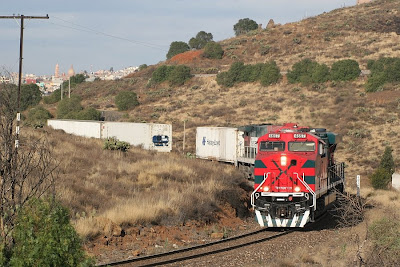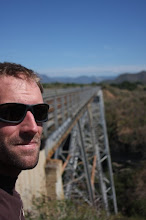 Immediately south of Torreon, Linea A enters a deep valley along the Rio Aguanaval. This military train is backing into the siding at Picardias in order to let two northbound trains pass by.
Immediately south of Torreon, Linea A enters a deep valley along the Rio Aguanaval. This military train is backing into the siding at Picardias in order to let two northbound trains pass by. The same military train crossing Rio Aguanaval as it enters a narrow canyon.
The same military train crossing Rio Aguanaval as it enters a narrow canyon. One of the last pasenger train in Mexico runs on this territorry from Felipe Pescador to Torreon. The weekly train serves the isolated rural communities in parts of Durango and Zacatecas states. Here the train is passing through the short canyon between Picadias and Juan Eugenio on its southbound run to Felipe Pescador.
One of the last pasenger train in Mexico runs on this territorry from Felipe Pescador to Torreon. The weekly train serves the isolated rural communities in parts of Durango and Zacatecas states. Here the train is passing through the short canyon between Picadias and Juan Eugenio on its southbound run to Felipe Pescador. North of Felipe Pescador, Linea A connects with FC Coahuila y Durango's southern line to Durango. Above, a southbound unit grain train is seen approaching the junction. The track in the foreground in the north leg of the wye. Below, the DPU's are visible as the trian curves toward the town of "Felipe."
North of Felipe Pescador, Linea A connects with FC Coahuila y Durango's southern line to Durango. Above, a southbound unit grain train is seen approaching the junction. The track in the foreground in the north leg of the wye. Below, the DPU's are visible as the trian curves toward the town of "Felipe."
Felipe Pescador
Felipe Pescador, Zacatecas is a the crew change point for trains between Torreon and Aguascalientes. It is a real railroad town, home to a large contract car shop and a small yard. A hotel across from the depot lodges train crews while they layover.
 A yard job sits on the mainline in front of the depot at Felipe Pescador. Meanwhile in the yard workers begin a day of repaing a line of boxcars.
A yard job sits on the mainline in front of the depot at Felipe Pescador. Meanwhile in the yard workers begin a day of repaing a line of boxcars.
 An outbound engineer is inspecting the locomotives of his northbound train prior to departing for Torreon.
An outbound engineer is inspecting the locomotives of his northbound train prior to departing for Torreon. Another northbound train pulls up to the depot while several outbound crews wait for their trains to arrive.
Another northbound train pulls up to the depot while several outbound crews wait for their trains to arrive. As a northbound grain train departs Felipe on the mainline, the brakeman runs ahead to line a switch while the train keeps moving.
As a northbound grain train departs Felipe on the mainline, the brakeman runs ahead to line a switch while the train keeps moving.
 The depot at Felipe is a busy place. Most of the town's comerce is located right around the yard. Above, a local ice cream vendor carries his cart across the tracks to the depot while another northbound train approaches.
The depot at Felipe is a busy place. Most of the town's comerce is located right around the yard. Above, a local ice cream vendor carries his cart across the tracks to the depot while another northbound train approaches.
 A southbound grain train departs Felipe Pescador. The large car-shop building is visible to the left, as is the venerable water tower.
A southbound grain train departs Felipe Pescador. The large car-shop building is visible to the left, as is the venerable water tower.
 At Mezquite, a northbound grain train winds through the curves in the early morning.
At Mezquite, a northbound grain train winds through the curves in the early morning.
Zacatecas
 A northbound manifest train is descending the north slope of the grade from Zacatecas.
A northbound manifest train is descending the north slope of the grade from Zacatecas.
 The tracks loop through the residential neighborhoods of Zacatecas before reaching the summit at the old passenger station. Although passenger trains no longer serve Zacatecas, the station building and platforms are maintained very well.
The tracks loop through the residential neighborhoods of Zacatecas before reaching the summit at the old passenger station. Although passenger trains no longer serve Zacatecas, the station building and platforms are maintained very well.  A northbound automobile train is looping around a canyon while climbing the south slope toward Zacatecas.
A northbound automobile train is looping around a canyon while climbing the south slope toward Zacatecas. A southbound intermodal train is passing through the looping curves on the south side of Zacatecas. The church to the left is located at the summit of the pass, on the edge of the historical centro.
A southbound intermodal train is passing through the looping curves on the south side of Zacatecas. The church to the left is located at the summit of the pass, on the edge of the historical centro.
 A long northbound manifest train is down to a crawl as it climbs toward Zacatecas. La Buffa - the famous bluffs above the city - are visible above the locomotives. (low resolution scan from slide)
A long northbound manifest train is down to a crawl as it climbs toward Zacatecas. La Buffa - the famous bluffs above the city - are visible above the locomotives. (low resolution scan from slide)
 South of Zacatecas, Linea A drops into the valley of Aguascalientes. This northbound is climbing out of the valley where the tracks wind along the hillsides.
South of Zacatecas, Linea A drops into the valley of Aguascalientes. This northbound is climbing out of the valley where the tracks wind along the hillsides. South of Aguascalientes, the tracks wind through northeast Jalisco state. This is where the line enters the Bajio - the historic and fertile central valley of Mexico. Above, a southbound grain train is dropping into Santa Maria Traspontina - near San Juan de los Lagos.
South of Aguascalientes, the tracks wind through northeast Jalisco state. This is where the line enters the Bajio - the historic and fertile central valley of Mexico. Above, a southbound grain train is dropping into Santa Maria Traspontina - near San Juan de los Lagos.
 A southbound unit grain train passes through some curves near San Juan de los Lagos.
A southbound unit grain train passes through some curves near San Juan de los Lagos.
 The same train is setting its out cars at a grain elevator.
The same train is setting its out cars at a grain elevator.
 A southbound manifest train leaving the city of Leon. This train is nearing the terminal of Irapuato, the junction between lines to Guadalajara and Mexico City.
A southbound manifest train leaving the city of Leon. This train is nearing the terminal of Irapuato, the junction between lines to Guadalajara and Mexico City.







2 comments:
I have to say, I love your information on these lines. How many trains per day run on Linea A? Also, how many run on KCSM's mainlines in Mexico (it's Linea B, Lazaro Cardenas, Veracruz, and Tampico lines)? And how many trains per day run on the Ferrosur trunk line? Finally, how many trains per day operate on Ferromex's Manzanillo mainline and on Ferromex's Guadalajara-Benjamin Hill mainline? Thanks for any info! I love your blogs and would love to go visit these places sometime! Do you think that Ferromex will ever signal the Linea A?
Seller Fullz, Pros, Leads (USA-UK-CANADA)
Fresh Database of USA, UK, CANADA & many more
USA / UK / CANADA Fullz Info
----------------------------------------
USA DL Photos SSN + Selfie
Business owner leads
Payday leads
Sweepstakes
Loan leads
Sweepstakes
Home owner leads
Employee leads
USA Bank leads
Email combos
Mortgage leads
Crypto database
Casinos database
Forex database
Stock Market Trader leads
Many Countries Fullz Available
USA|UK|CANADA|RU|AUS|FR|ASIA
For more stuff Hit me at:
Whats App : (+1.. 605.. 846... 1870..)
TG Chanel : t.me/bigdatatrader
Telegram : @ Fullzpros
VK Messenger ID : Fullzpros
Email : Harrynelson03(at)protonmail.com
Post a Comment